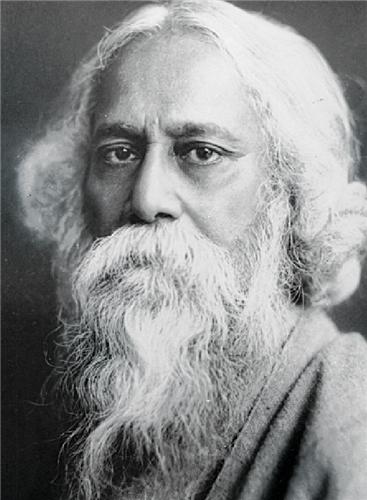RABINDRANATH TAGORE
“A great writer, great poet, great novelist, great educationist and an early advocate of Independence for India, Tagore won the Nobel Prize for Literature in 1913. Two years later, he was also awarded the Knighthood by the British Government but he surrendered it in 1919, as a protest against the Jallianwala Massacre of Amritsar where the British troops killed more than 400 Indian demonstrators.”
Rabindranath Tagore was born in Calcutta into a wealthy and prominent Brahmin family. His father, Maharishi Debendranath Tagore, was a religious reformer and scholar. His mother, Sarada Devi, died when Tagore was very young. Tagore’s grandfather had established a huge financial empire for himself.
Rabindranath Tagore was the youngest son of Debendranath Tagore, a leader of the Brahma Samaj, which was a new religious sect of 19th century Bengal and which attempted a revival of the ultimate monistic basis of Hinduism as laid down in the Upanishads. He was educated at home; and although at 17 only, he was sent to England for formal schooling, he could not finish his studies there. However, in ‘My Reminiscences’ Tagore mentions that it was not until the age of ten when he started to use socks and shoes. Tagore started to compose poems at the age of eight. Tagore’s first book, a collection of poems, appeared when he was 17. It was published by Tagore’s friend who wanted to surprise him. In his matured years, in addition to his many-sided literary activities, he managed the family estates, a project which brought him into close touch with common humanity and increased his interest in social reforms. He also started an experimental school at Shantiniketan, where he tried his Upanishad ideals of education. From time-to-time, he participated in the Indian nationalist movement, though in his own non-sentimental and visionary way.
Tagore married Mrinalini Devi Raichaudhuri in 1883. He had two sons and three daughters. In 1890, Tagore moved to East Bengal (now Bangladesh), where he collected local legends and folklore. Between 1893 and 1900, he wrote seven volumes of poetry, including Sonar Tari (The Golden Boat) in 1894 and Khanika, in 1900. This was a highly prolific period in Tagore’s life that earned him rather a misleading epitaph ‘The Bengali Shelley.’ More important was that Tagore wrote in the common language of the people. This also was something that was hard to be accepted among his critics and scholars. Tagore was the first Indian to bring an element of psychological realism to his novels. Among his early major prose works are Chocher Bali (1903, Eyesore) and Nashtanir (1901, The Broken Nest), published first serially. Between 1891 and 1895, he got published forty-four short stories in Bengali periodicals, most of them in the monthly journal Sadhana. Tagore’s short stories influenced the Indian Literature a lot. ‘Punishment’, a much anthologized work, was set in a rural village. It describes the oppression of women through the tragedy of a low-caste Rui family. In 1901, Tagore founded a school outside Calcutta, Visva-Bharati, which was dedicated to emerging Western and Indian philosophy and education, which became a university in 1921. He produced poems, novels, stories, a history of India, textbooks and treatises on pedagogy. His wife Mrinalini Devi, died in 1902, next year one of his daughters also died and in 1907, he lost his younger son.
Tagore’s recognition as a writer was established in the United States and England after the publication of Gitanjali, which was translated into English by himself. In the introduction from 1912 William Butler Yeats wrote “These lyrics— which are in original, full of subtlety of rhythm, of untranslatable delicacies of colour, of metrical invention—display in their thought a world I have dreamed of all my life long.” Tagore’s poems were also praised by Ezra Pound and drew the attention of the Nobel Prize Committee. “There is in him the stillness of nature. The poems do not seem to have been produced by storm or by ignition, but seem to show the normal habit of his mind. He is at one with nature, and finds no contradictions. And this is in sharp contrast with the Western mode where man must be shown attempting to master nature if we are to have ‘great drama.’ (Ezra Pound in Fortnightly Review, 1st March, 1913).
Most of the Tagore’s ideology comes from the teachings of the Upanishads up and from his own beliefs that God can be found through personal purity and service to others. He stressed the need for a new world order based on transnational values and ideas, the ‘unity consciousness’ politically active in India, Tagore was a supporter and friend of Gandhi, but warned of the dangers of nationalistic thought. Unable to gain ideological support to his views, he retired into relative solitude. He travelled widely from Japan to South-East Asia from 1916 to 1927 and Jatri in 1929. His Majesty, Riza Shah Pahlavi, invited Tagore to Iran in 1932. On his journeys while delivering lecture, Tagore attempted to spread the ideal of uniting East and West. While in Japan he said: “The Japanese do not waste their energy in useless screaming and quarrelling, and there is no waste of energy. It is used only when required. This calmness and fortitude of body and mind is part of their national self-realization.”
At the age of 70, Tagore took up painting. Although Tagore wrote successfully in all literary genres, he was first of all a poet. Among his fifty and odd volumes of poetry are Manasi (1890) [The Ideal One], Sonar Tari (1894) [The Golden Boat], Gitanjali (1910) [Song Offerings], Gitimalya (1914) [Wreath of Songs] and Balaka (1916) [The Flight of Cranes]. The English renderings of his poetry, which include The Gardener (1913), Fruit-Gathering (1916), and The Fugitive (1921), do not generally correspond to particular volumes in the original Bengali; and in spite of its title, Gitanjali: Song Offerings (1912), the most acclaimed of them, contains poems from other works besides its namesake, Tagore’s major plays are Raja (1910), [The King of the Dark Chamber], Dakghar (1912), [The Post Office], Achalayatan (1912) [The Immovable], Muktadhara (1922), [The Waterfall], and Raktakaravi (1926) [Red Oleanders]. He is the author of several volumes of short stories and a number of novels, among which are Gora (1910), Ghare-Baire (1916) [The Home and the World], and Yogayog (1929) [Crosscurrents]. Besides these, he wrote musical dramas, dance dramas, essays of all types, travel diaries, and two autobiographies, one in his middle years and the other shortly before his death on 7th August, 1941.Tagore’s ‘Our Golden Bengal’ became the national anthem of Bangladesh. His contribution to the literature is unmatchable.

